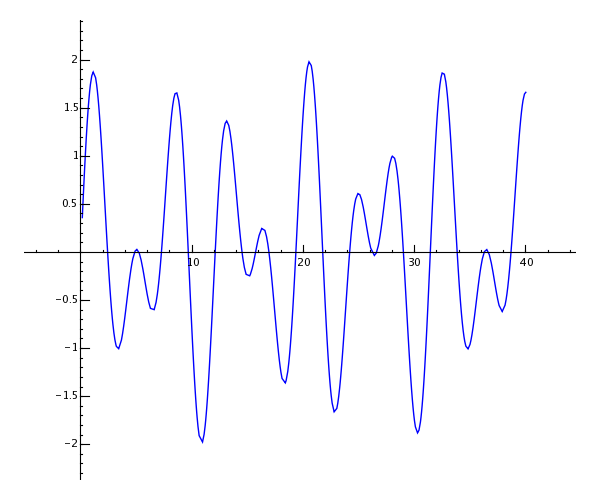This is a tour of Sage that closely follows the tour of Mathematica that is at the beginning of the Mathematica Book.
The Sage command line has a sage: prompt; you do not have to add it. If you use the Sage notebook, then put everything after the sage: prompt in an input cell, and press shift-enter to compute the corresponding output.
sage: 3 + 5
8
The caret symbol means “raise to a power”.
sage: 57.1 ^ 100
4.60904368661396e175
We compute the inverse of a  matrix in Sage.
matrix in Sage.
sage: matrix([[1,2], [3,4]])^(-1)
[ -2 1]
[ 3/2 -1/2]
Here we integrate a simple function.
sage: x = var('x') # create a symbolic variable
sage: integrate(sqrt(x)*sqrt(1+x), x)
1/4*((x + 1)^(3/2)/x^(3/2) + sqrt(x + 1)/sqrt(x))/((x + 1)^2/x^2 - 2*(x + 1)/x + 1) + 1/8*log(sqrt(x + 1)/sqrt(x) - 1) - 1/8*log(sqrt(x + 1)/sqrt(x) + 1)
This asks Sage to solve a quadratic equation. The symbol == represents equality in Sage.
sage: a = var('a')
sage: S = solve(x^2 + x == a, x); S
[x == -1/2*sqrt(4*a + 1) - 1/2, x == 1/2*sqrt(4*a + 1) - 1/2]
The result is a list of equalities.
sage: S[0].rhs()
-1/2*sqrt(4*a + 1) - 1/2
sage: show(plot(sin(x) + sin(1.6*x), 0, 40))

First we create a  matrix of random
numbers.
matrix of random
numbers.
sage: m = random_matrix(RDF,500)
It takes Sage a few seconds to compute the eigenvalues of the matrix and plot them.
sage: e = m.eigenvalues() #about 2 seconds
sage: w = [(i, abs(e[i])) for i in range(len(e))]
sage: show(points(w))

Thanks to the GNU Multiprecision Library (GMP), Sage can handle very large numbers, even numbers with millions or billions of digits.
sage: factorial(100)
93326215443944152681699238856266700490715968264381621468592963895217599993229915608941463976156518286253697920827223758251185210916864000000000000000000000000
sage: n = factorial(1000000) #about 2.5 seconds
This computes at least 100 digits of  .
.
sage: N(pi, digits=100)
3.141592653589793238462643383279502884197169399375105820974944592307816406286208998628034825342117068
This asks Sage to factor a polynomial in two variables.
sage: R.<x,y> = QQ[]
sage: F = factor(x^99 + y^99)
sage: F
(x + y) * (x^2 - x*y + y^2) * (x^6 - x^3*y^3 + y^6) *
(x^10 - x^9*y + x^8*y^2 - x^7*y^3 + x^6*y^4 - x^5*y^5 +
x^4*y^6 - x^3*y^7 + x^2*y^8 - x*y^9 + y^10) *
(x^20 + x^19*y - x^17*y^3 - x^16*y^4 + x^14*y^6 + x^13*y^7 -
x^11*y^9 - x^10*y^10 - x^9*y^11 + x^7*y^13 + x^6*y^14 -
x^4*y^16 - x^3*y^17 + x*y^19 + y^20) * (x^60 + x^57*y^3 -
x^51*y^9 - x^48*y^12 + x^42*y^18 + x^39*y^21 - x^33*y^27 -
x^30*y^30 - x^27*y^33 + x^21*y^39 + x^18*y^42 - x^12*y^48 -
x^9*y^51 + x^3*y^57 + y^60)
sage: F.expand()
x^99 + y^99
Sage takes just under 5 seconds to compute the numbers of ways to partition one hundred million as a sum of positive integers.
sage: z = Partitions(10^8).cardinality() #about 4.5 seconds
sage: str(z)[:40]
'1760517045946249141360373894679135204009'
Whenever you use Sage you are accessing one of the world’s largest collections of open source computational algorithms.